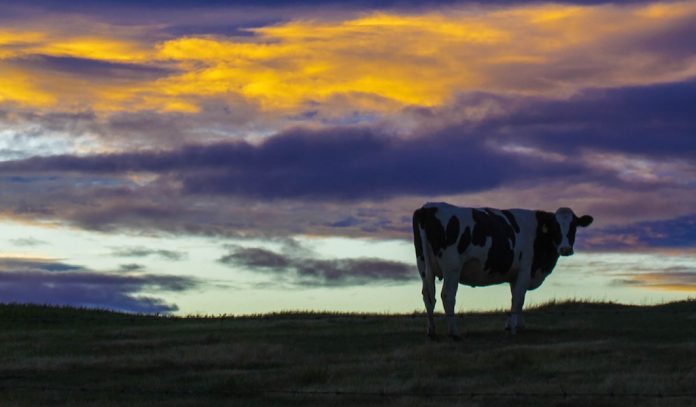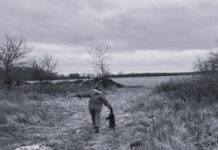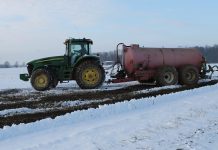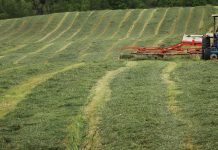By Susan Crowell / editor@farmanddairy.com
Ninety years ago, C.R. Arnold, an ag economist at Ohio State University, told a crowd of 300 Ohio farmers that there are basically three ways for a farmer to reduce production costs: doing a bigger business, using labor more efficiently, and getting bigger yields.
“Too many farmers,” Arnold said, “are doing business on too small a scale on their farms. Taxes, insurance, interest and depreciation go on and are about the same whether we sell 10 hogs or over 100 hogs a year from the same farm.
“Nor does a 160-acre farm require twice as much equipment and labor, or twice as many buildings and fences as an 80-acre farm. The small farm business is too costly per unit; there is too much overhead.”
I share these words from the front page of the June 21, 1929, Farm and Dairy for a couple reasons.
First, we often hear today that universities or Extension or other experts are guilty of telling farmers to get bigger. No, the reality is just as this economist pointed out nearly 100 years ago — there are economies of scale, regardless of commodity.
As the future of our farms seems to spiral out of our control, know this: The one thing you will always control is your farm’s management.
Second, Arnold’s original words, and the words of others ever since, are a reminder that management is as important as anything else on your farm.
It’s not about equipment, or acres or herd size. A poor manager of a small farm is not going to magically be profitable by adding acres, and a poor manager of a larger farm is not going to get back into the black by selling all the cattle or scaling back.
As the future of our farms seems to spiral out of our control, know this: The one thing you will always control is your farm’s management.
Feeding decisions, breeding decisions, machinery investments, land use and acquisition, conservation implementation, risk management, herd health, soil fertility, employees (finding them and keeping them), data (so much information!), marketing, critical thinking and problem solving — you control these things. Get better at them.
You can’t farm in the “same old, same old” mode. What worked yesterday is not necessarily what will work today and is not going to work tomorrow.
Here’s the bottom line: You do you. Farm your farm, not someone else’s idea of your farm. Recognize your own skills and develop a farm business around those skills.
Last week, I closed my letter to the next Farm and Dairy editor, Rebecca Miller, with the final words, “Be Bold.” This week, I exhort you to do the same.
Be honest about what sucks your time away from priorities (and first be honest about your priorities). Dare to look at your farm with critical eyes. With fresh eyes. See what is working or what legacy enterprise should’ve been ditched a long time ago.
Don’t let your own faults and weaknesses obscure your potential to succeed. Seek outside counsel in areas where your own skills are weak. There is no shame in asking for help or to trust someone outside the operation to give you advice.
I would also leave you with this: That original 1929 article also shared wise words from Verna Elsinger, then director of home and community work with the Ohio Farm Bureau Federation.
“The ultimate ‘farm crop’ is women and men, girls and boys,” Elsinger said. “Things are important only as they contribute to human happiness, satisfaction and well being.”
This is the year to jot that lesson down on a piece of paper and put it where you’ll see it every day — because that farm crop is one that won’t get flooded.
(Editor Susan Crowell can be reached at 800-837-3419 or at editor@farmanddairy.com until the end of June, when she is retiring after 34 years with the paper.)














Happy retirement to you….. 😍
I can not disagree more!!! No matter how well a person manages a farm, prices farmers receive for their agricultural products are far too small for smaller herds/ crop acreages to keep up with the costs of production and living. Trucks cost $3000 in the early 1970s, and milk prices were $9-12 cwt. Property taxes were less than 1/4 of what they are now-and land could be bought for hundreds $$ per acre. EVERYTHING cost MUCH less then, but prices for farm products were just as much as they are now. Today, trucks cost $70,000 or more, taxes double every few years, and land is thousands of $$/acre EVERYTHING costs MORE-yet farmers receive the same or less for their products. A newspaper with farm prices from 1926 was found in an old house the fire department was asked to burn-farmers literally were receiving MORE for cattle in 1926 than they do today, and grain prices were slightly higher per bushel. The bible prophesies list food shortages and famine-the fact that farmers are being pushed out of business and people take food for granted are allowing these prophesies to come true….instead of telling small farmers they can ‘make it’ if they make ‘better’ business decisions when they don’t have ‘a snowballs chance in hades’ consumers need to be woken up and warned about the cost of their desire for cheap food and the governments involvement in pushing for cheap food…as the bible warns:’it (the quickness) will be as a thief in the night’